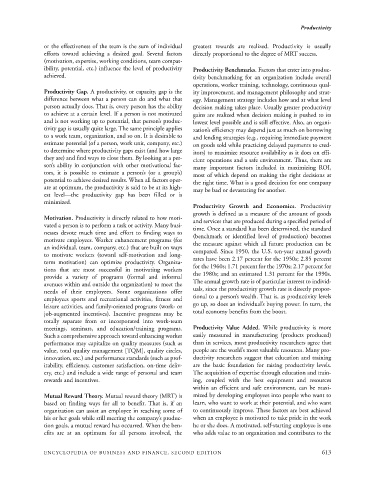Page 636 - Encyclopedia of Business and Finance
P. 636
eobf_P 7/5/06 3:18 PM Page 613
Productivity
or the effectiveness of the team is the sum of individual greatest rewards are realized. Productivity is usually
efforts toward achieving a desired goal. Several factors directly proportional to the degree of MRT success.
(motivation, expertise, working conditions, team compat-
ibility, potential, etc.) influence the level of productivity Productivity Benchmarks. Factors that enter into produc-
achieved. tivity benchmarking for an organization include overall
operations, worker training, technology, continuous qual-
Productivity Gap. A productivity, or capacity, gap is the ity improvement, and management philosophy and strat-
difference between what a person can do and what that egy. Management strategy includes how and at what level
person actually does. That is, every person has the ability decision making takes place. Usually greater productivity
to achieve at a certain level. If a person is not motivated gains are realized when decision making is pushed to its
and is not working up to potential, that person’s produc- lowest level possible and is still effective. Also, an organi-
tivity gap is usually quite large. The same principle applies zation’s efficiency may depend just as much on borrowing
to a work team, organization, and so on. It is desirable to and lending strategies (e.g., requiring immediate payment
estimate potential (of a person, work unit, company, etc.) on goods sold while practicing delayed payments to cred-
to determine where productivity gaps exist (and how large itors) to maximize resource availability as it does on effi-
they are) and find ways to close them. By looking at a per- cient operations and a safe environment. Thus, there are
son’s ability in conjunction with other motivational fac- many important factors included in maximizing ROI,
tors, it is possible to estimate a person’s (or a group’s)
most of which depend on making the right decisions at
potential to achieve desired results. When all factors oper-
the right time. What is a good decision for one company
ate at optimum, the productivity is said to be at its high- may be bad or devastating for another.
est level—the productivity gap has been filled or is
minimized.
Productivity Growth and Economics. Productivity
growth is defined as a measure of the amount of goods
Motivation. Productivity is directly related to how moti-
and services that are produced during a specified period of
vated a person is to perform a task or activity. Many busi- time. Once a standard has been determined, the standard
nesses devote much time and effort to finding ways to
(benchmark or identified level of production) becomes
motivate employees. Worker enhancement programs (for
the measure against which all future production can be
an individual, team, company, etc.) that are built on ways compared. Since 1950, the U.S. ten-year annual growth
to motivate workers (toward self-motivation and long-
term motivation) can optimize productivity. Organiza- rates have been 2.17 percent for the 1950s; 2.85 percent
tions that are most successful in motivating workers for the 1960s; 1.71 percent for the 1970s; 2.17 percent for
the 1980s; and an estimated 1.31 percent for the 1990s.
provide a variety of programs (formal and informal
The annual growth rate is of particular interest to individ-
avenues within and outside the organization) to meet the
needs of their employees. Some organizations offer uals, since the productivity growth rate is directly propor-
tional to a person’s wealth. That is, as productivity levels
employees sports and recreational activities, fitness and
leisure activities, and family-oriented programs (work- or go up, so does an individual’s buying power. In turn, the
job-augmented incentives). Incentive programs may be total economy benefits from the boost.
totally separate from or incorporated into work-team
meetings, seminars, and education/training programs. Productivity Value Added. While productivity is more
Such a comprehensive approach toward enhancing worker easily measured in manufacturing (products produced)
performance may capitalize on quality measures (such as than in services, most productivity researchers agree that
value, total quality management [TQM], quality circles, people are the world’s most valuable resources. Many pro-
innovation, etc.) and performance standards (such as prof- ductivity researchers suggest that education and training
itability, efficiency, customer satisfaction, on-time deliv- are the basic foundation for raising productivity levels.
ery, etc.) and include a wide range of personal and team The acquisition of expertise through education and train-
rewards and incentives. ing, coupled with the best equipment and resources
within an efficient and safe environment, can be maxi-
Mutual Reward Theory. Mutual reward theory (MRT) is mized by developing employees into people who want to
based on finding ways for all to benefit. That is, if an learn, who want to work at their potential, and who want
organization can assist an employee in reaching some of to continuously improve. These factors are best achieved
his or her goals while still meeting the company’s produc- when an employee is motivated to take pride in the work
tion goals, a mutual reward has occurred. When the ben- he or she does. A motivated, self-starting employee is one
efits are at an optimum for all persons involved, the who adds value to an organization and contributes to the
ENCYCLOPEDIA OF BUSINESS AND FINANCE, SECOND EDITION 613

